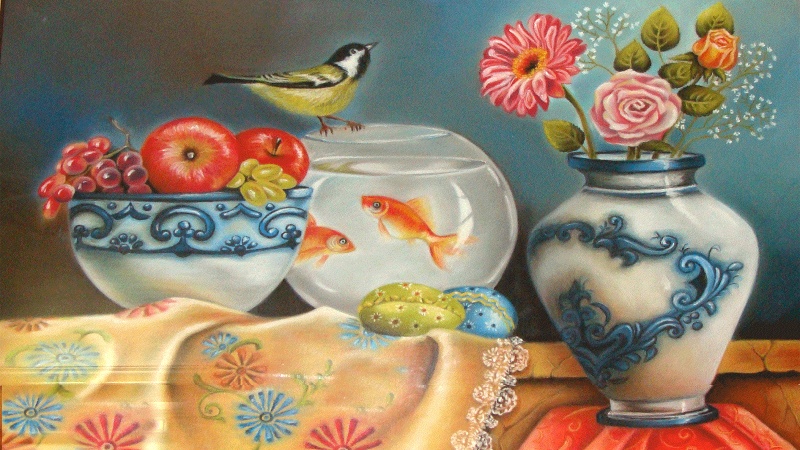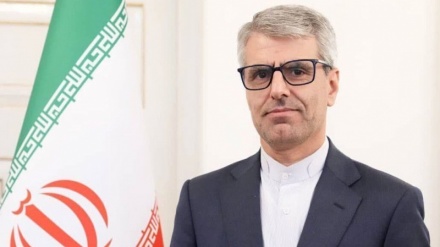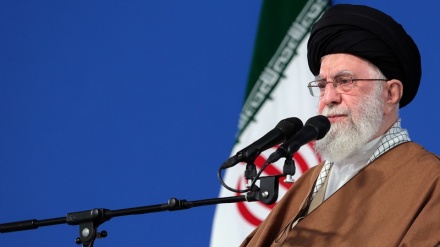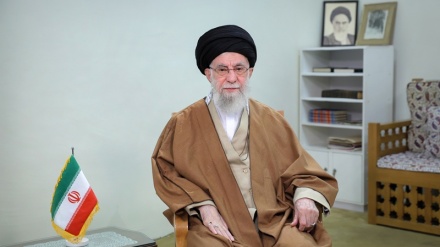Nowrouz (4)
Welcome to the 4th episode of our programme, Nowrouz , which literally means “New Day”. Nowrouz is the Iranian New Year, which is celebrated each year on the first day of spring. In today’s programme, we look at the customs and traditions of Nowrouz in many countries. We look at how different peoples and nations celebrate Nowrouz.
In our last programme we talked of the geography of Nowrouz. This ancient festivity, of Iranian origin is celebrated in a vast region -- from the fringes of China to Central Asia, from Anatolia to Mesopotamia, from the Caucasus to the Indian Ocean. Nowrouz is an official public holiday in the Islamic Republic of Iran, Afghanistan, Tajikistan, the Republic of Azerbaijan, Uzbekistan, Turkmenistan, Kazakhstan, Kirgizstan, Pakistan, India, and Albania. In all these countries this public holiday is known as Nowrouz. There are also quite a few countries where Nowrouz is unofficially celebrated, by at least a section of the population. In some of these countries although Nowrouz is not an official holiday, large numbers of people, nonetheless, do celebrate it. For example we can mention Syria or Turkey. Although Nowrouz is not a public holiday in Syria or Turkey, the Kurds of Syria and Turkey celebrate Nowrouz, and have done so since ancient times. The longevity of Nowrouz is due to the many socially-valuable customs and traditions which are associated with it, as well as Nowrouz’s close connection to nature and spring. For example the tradition of visiting the elder members of your family during Nowrouz, is beneficial not just for the individual and families concerned, but it is also beneficial for society as a whole. The customs and traditions of Nowrouz are somewhat different from nation to nation, and from people to people, but there are also many similarities as well. Let us now take a look at customs and traditions of Nowrouz in different nations.
The Islamic Republic of Iran is home to many different ethnic and linguistic groups and religions. For example there Turks, Kurds, Lors, Baluchs , Fars, Gilak, Arabs and various other ethnicities living in Iran. But all of these different ethnic and linguistic groups celebrate Nowrouz in a very similar manner, observing identical, or very similar, customs and traditions. Thus Nowrouz has always been a unifying factor in Iran, bringing all Iranians together. There are many customs and traditions associated with Nowrouz in Iran—for example buying new clothes in the run-up to Nowrouz, and wearing new clothes on the Day of Nowrouz; cleaning the house thoroughly in the run-up to Nowrouz , setting the “Haft-Sin spread or Haft-Sin Table” (traditionally seven items which begin with the letter ‘Sin’ or ‘S’ are placed on a table or spread in anticipation of Nowrouz), reading the Holy Qur’an on the Day of Nowrouz, with the ushering of the new year, reading the poetry of ‘Hafez’, the famous Iranian poet, making sure that there are “green shoots” on the “Haft-Sin Spread or Table”, giving money to children and younger members of the Family, giving and receiving of gifts to and from family members, visiting family and relatives, particularly the elders of the family or relatives, during the Nowrouz holidays, it is particularly important to show your respect to elder members of your family, walking and picnicking in nature and outdoors (this is particularly important on the thirteenth day of Nowrouz, but it is not just limited to that day).
In Iran, Nowrouz symbolizes change and transformation. It is also very important to set aside differences and divisions, and to renew friendships during Nowrouz. Just as Iranians clean their houses and apartments thoroughly in the run-up to Nowrouz, they are also expected to clean their hearts from any hatred or division, and to renew their friendships. This is a very important part of Nowrouz, and indeed many Iranians consider it an essential part of Nowrouz. Iranians gather round the “Haft-Sin Table-Spread” as the clock ticks away and ushers in the new Year (traditionally seven items which begin with the letter ‘S’ are placed on this table or spread, in addition to a mirror, The Holy Qur’an and water). It should also be noted that the “Haft-Sin” is also a Nowrouz tradition in The Republic of Azerbaijan and Afghanistan.
In Kabul, and in northern Afghanistan, there is a tradition of seven fruits spread or seven fruits table. Instead of placing seven items beginning with ‘S’, in northern Afghanistan seven fruits are placed on the table spread. These are usually apricots, red and green raisins, almonds, pistachio nuts, and ‘senjed’ (which is a type of fruit). Shi’ite Muslims in Pakistan also have a very similar tradition for Nowrouz. They place seven dried fruits on the table-spread, since Nowrouz is associated in the Subcontinent, and in religious circles in Iran and Iraq, with the Commander of the Faithful, Imam Ali ibn Abi Taleb (PuH).
One of the most common food items, which is cooked and prepared especially for Nowrouz, is called Samanu in Iran, and it is called Samnak, Sumnak, Sumlak, Samani, and Samaneh in other countries and lands which celebrate Nowrouz. Samanu is essentially cooked wheat germ, and it tastes sweet. In most countries which celebrate Nowrouz, Samanu is cooked especially for the festivity. In some countries the cooking of Samanu is undertaken collectively, with groups of women and girls cooking Samanu. Sometimes, the cooking takes place at night, and women and girls sing special songs as they cook. This is the case, for example, in parts of Iran, Afghanistan, Tajikistan, Turkmenistan, and Uzbekistan.
In Pakistan, many people celebrate Nowrouz, particularly in northern Pakistan and in “sarhad” province, where special religious and national customs are associated with Nowrouz. In northern Pakistan and “sarhad” province, colourful flags and lights are used to decorate streets and towns. In Pakistan Nowrouz is celebrated with gatherings and parties, and it is called “Alam Afrouz”, which literally means “to light up the world”. As Nowrouz or new day dawns, it lights up the world. In Pakistan too, just as in Iran, people clean their homes in the run-up to Nowrouz, they visit family and relatives, they cook special foods and sweets for Nowrouz, and they give gifts and money to children and younger members of the family. As we said earlier, Nowrouz is mentioned in several Islamic hadith and for this reason the followers of the Ahl al-Bayt, in Pakistan, Kashmir, and parts of India, mark it as a religious festival. A hadith narrated by Imam Ja’far Sadeq (PuH), the 6th Infallible Heir of Prophet Mohammad (blessings of God upon him and his progeny), says regarding the significance of Nowrouz:
“The sun attained its brightness, the wind started to blow, the Ark of Prophet Noah stopped near Mount Joudi and was saved from drowning, Prophet Abraham broke the idols of his community, Archangel Gabriel brought the first revelation to our Prophet (Mohammad - SAWA), the Prophet lifted Imam Ali (AS) on his shoulders so that he could topple the idols from the Ka'ba, and the Prophet announced Imam Ali (AS) as his successor at Ghadir-e-Khom.”
In another hadith Imam Ja’far Sadeq (AS):
“Today is the day on which God made a pact with His servants to pray to Him not to follow polytheism but to follow the Prophets and the Ahl al-Bayt. On this day the last Imam, the Awaited Mahdi (AS) is expected to reappear...”
In Tajikistan, too, Nowrouz is celebrated with zeal, particularly in the south eastern province of Badakhshan, where it has been celebrated for thousands of years. Nowrouz is a national public holiday in Tajikistan. The Tajiks see Nowrouz as the “key to friendship or secret of friendship” and “the revival of nature, animals and plants”. In Tajikistan, and especially in Badakhshan province, people clean their houses as we approach Nowrouz, they dust off plates, glasses and cutlery, they also cook a variety of dishes and various sweets especially for Nowrouz. Games and sporting activities takes place before and during Nowrouz. These include egg games, swings, and wrestling competitions of various kinds. They also cook traditional foods such as rice and stews. Tajik people also sit round the “Haft Sin Table or spread” as the clock ushers in the New Year.
In Kazakhstan, too, people celebrate the Nowrouz. Kazakhs believe that on the day of Nowrouz, the earth is showered with blessings!! As Nowrouz approaches, two candles are lit in every house, and the house is cleaned thoroughly. The Kazakh people believe that if your house is tidy and clean when the New Year starts, then those who live in the house will stay healthy, and will not become ill during that particular year. They also believe that a clean and tidy house at the start of the year will “bring good luck for all the occupants of that house”.
On the actual day of Nowrouz (the first day of spring) the Kazakh people wear new clothes and many wear white new clothes, because “white is the colour of happiness”. The Kazakh people also visit their family, relatives, and friends during the Nowrouz holidays. Many famous sporting competitions also take place during Nowrouz.
The Kurdish people too, living in Iran, Iraq, Turkey and Syria, celebrate Nowrouz with all its glory, observing all the traditions and customs of Nowrouz. There are several different dialects of Kurdish, and Kurdish people have different religions, but one thing they all have in common, is that all Kurds celebrate Nowrouz. Traditionally the Kurdish people light up a fire, when the New Year is ushered in. The “fire of Nowrouz” is based on ancient Kurdish beliefs. Usually the highest point in a locality is chosen to light up a fire, which of course, in an urban setting, means lighting a fire on the roofs of houses or apartment blocks. Many Kurds observe this tradition. For the Kurds, the day of Nowrouz represents “not only a day of wealth and blessing, but also a day of peace, reconciliation, and friendship”. The Kurdish people of the city of “Mardin”, in southern Turkey, wear new clothes on the day of Nowrouz, and they visit family, relatives and friend on the morning of the first day of Nowrouz. Later on that day, they gather in one of the main squares in the town of Mardin, and celebrate Nowrouz together.
The “Zaza Kurds” of Turkey, who live mostly in eastern Anatolia, and speak “Zaza Kurdish”, always celebrate Nowrouz, which usually falls on 21st March each year. The “Zaza Kurds” take part in a series of customs and rituals on the first day of Nowrouz, which they call the “customs and rituals of Jam”. It is worth noting that music is an essential part of the Nowrouz customs and traditions of “Zaza Kurds”.
With the arrival of Nowrouz and spring, Tashkent, the Uzbek capital, has a different feel to it. The Uzbek people put up colourful flags and lights in all streets and cul-de-sacs of Tashkent, decorating the streets of the Uzbek capital. They wash and clean the streets as Nowrouz approaches. The Uzbeks, like the other peoples of Central Asia, celebrate 21st March each year, as the day of Nowrouz. They gather in parks and cultural centres of Tashkent, on 21st March, rejoicing and celebrating Nowrouz. People generally wear traditional Uzbek clothes on this day, and visit their family and relatives, particularly the elders of the family. Other minorities in Russia, such as the “Tartars”, also celebrate Nowrouz.
The cooking of Samanu is very important for the Uzbek people, and special ceremonies are observed when cooking Samanu for Nowrouz celebrations,. The Uzbek people also gather round the “Haft Sin Table or spread” as the clock ushers in the New Year. They also give gifts and money to children and young people.



